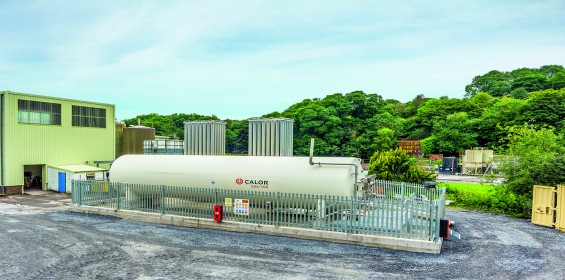Improving efficiency in off grid production
Published: 26 November, 2019
The introduction of tighter regulations around carbon emissions for thermal combustion plants is encouraging industrial businesses to explore cleaner fuel options. Oliver Knight, Industry sales manager, at Calor discusses the options for off-grid manufacturers and explains how one dairy producer has already cut its energy costs by nearly 29% per year.
The Medium Combustion Plant Directive requires all thermal combustion plant rated between 1MW and 50MW to apply for a permit which involves monitoring and complying with limits on carbon emissions. These new restrictions prevent the use of heavy fuel oil, leaving businesses looking for a more environmentally-friendly alternative.
For off-grid companies, this presents a particularly significant challenge. Natural gas is a much cleaner fossil fuel than oil, but the cost of creating a new connection to the Gas Distribution Network for a remote area can be in excess of several millions of pounds, making it unfeasible for many organisations. Thankfully, there are alternative fuels that offer the same level of performance, plus significant carbon savings, without mains access.
Off-grid options
Liquefied Petroleum Gas (LPG) and Liquefied Natural Gas (LNG) are the two main alternatives. LPG is a colourless, low carbon and highly efficient fuel with a wide variety of uses including manufacturing, transport, agriculture and home heating. LNG is made by cooling natural gas to -162°C, which shrinks the volume so that it takes up around 600 times less space than when in its gaseous form, making it easier and cheaper to transport and store. LNG is better than any other fossil fuel for the environment, as the combustion of natural gas releases significantly less CO2, NOx and SOx and virtually no ash or particulates.
LPG and LNG are incredibly versatile fuels and both are commonly used to power production. LNG is the ideal choice for businesses that have continuous demand for fuel and spend more than £80,000 a year on energy, whilst seasonal or stop/start production lines might be better off with LPG.
A success story
One organisation that has recently seen the benefits of switching from light fuel oil to LNG is Dairy Partners, a family-owned business that manufactures a range of cheese products – including mozzarella and pizza cheese – for some of the leading food brands in the UK and around the world.
By becoming the very first cheese manufacturer in the UK to be fuelled by LNG and investing in new boiler equipment, Dairy Partners is predicted to cut its annual energy costs by 29% and CO2 emissions by 30% at its Newcastle Emlyn site.
Calor supplied and installed a single, horizontal 60m3 above-ground LNG storage tank on the site, which is vacuum-insulated and features a twin ambient vaporiser system. The tank is also fitted with automatic top-up technology, so that an LNG delivery is automatically scheduled by Calor once it begins to run low on fuel.
Robert Peel, director at Dairy Partners, commented: “Steam is used in dairy production for process heating, which is very energy-intensive. Therefore, a fuel that can reduce our site’s energy consumption while improving our carbon output was a hugely attractive proposition. We upgraded the site from heavy fuel oil to light fuel oil as part of our on-going sustainability strategy, with the plan to upgrade to gas in the future. While we did consider biomass at one point, generating steam from this source is quite a complicated process and wasn’t a viable option on our site.
“We have cut our CO2 emissions by 30% whilst also reducing our costs. Relying on the tank’s built-in system to monitor fuel levels also helps us hugely from an operational perspective, as it’s a job we no longer have to fulfil on site with oil deliveries.”
Regulations around plant emissions are only likely to get stricter as the government works towards its pledge to become carbon neutral by 2050. By acting now and switching to a more energy efficient fuel, manufacturers can make substantial cost savings and future proof their operations.







